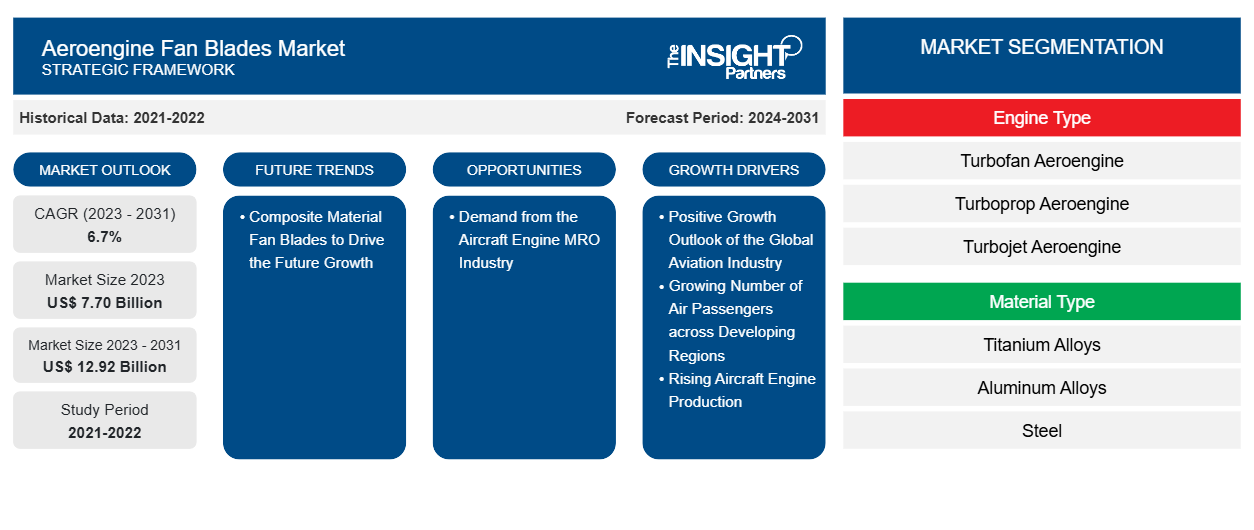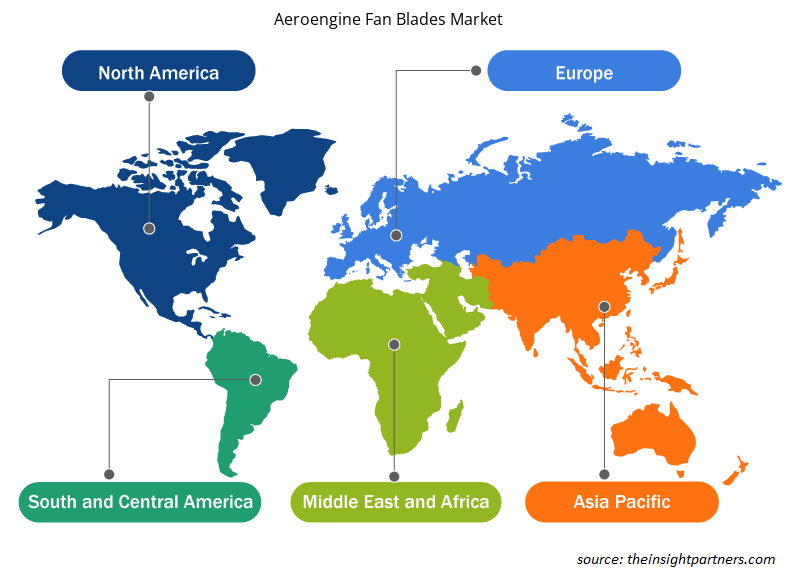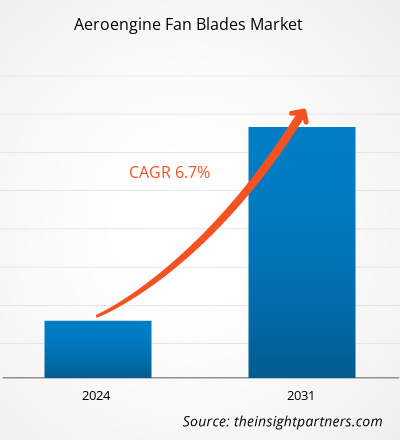Se proyecta que el tamaño del mercado de álabes de ventiladores para motores de aeronaves alcance los 12.920 millones de dólares estadounidenses en 2031, frente a los 7.700 millones de dólares estadounidenses en 2023. Se espera que el mercado registre una CAGR del 6,7 % entre 2023 y 2031. El crecimiento del mercado y la demanda de álabes de ventiladores para motores de aeronaves en varios países dependen de la presencia de actores de fabricación de aeronaves, fabricantes de motores de aeronaves, fabricantes de componentes de aeronaves y proveedores de servicios de mantenimiento, reparación y revisión. Algunos de los países clave que se prevé que impulsen la demanda de álabes de ventiladores para motores de aeronaves en los próximos años incluyen Estados Unidos, Reino Unido, Francia, Alemania, Rusia, China, Japón, Brasil, India y Turquía, entre otros.
Análisis del mercado de las aspas de ventilador de motores aeronáuticos
A continuación se presentan algunos de los puntos clave mencionados por algunos de los líderes de opinión clave que operan en el mercado de álabes de ventiladores para motores aeronáuticos :
- Los factores clave que afectan el crecimiento de la industria de la aviación mundial incluyen la demanda de viajes aéreos, los cambios regulatorios, los desarrollos de infraestructura y los avances tecnológicos.
- La demanda de viajes de bajo costo está aumentando a un ritmo impresionante en todas las geografías. Se prevé que la creciente popularidad y demanda de aviones comerciales de bajo costo y ultracompactos ofrecerá amplias oportunidades de crecimiento futuro para las empresas de álabes de ventilador para motores de aviación en todo el mundo.
- Se espera que la adopción de materiales compuestos por parte de los principales fabricantes de álabes de ventiladores, como GE Aviation, CFM International y Rolls-Royce Plc, junto con las actividades de investigación y desarrollo en curso para mejorar el rendimiento de varios materiales compuestos, impulsen el crecimiento de los álabes de ventiladores compuestos en el futuro cercano.
Descripción general del mercado de aspas de ventilador para motores aeronáuticos
El ecosistema del mercado de álabes de ventiladores para motores de aviación está formado por las partes interesadas mencionadas anteriormente. Estas partes interesadas incluyen proveedores de hardware/componentes; fabricantes de álabes de ventiladores para motores de aviación; empresas de mantenimiento, reparación y revisión (MRO); fabricantes de motores de aeronaves y usuarios finales. Los fabricantes adquieren constantemente materia prima de los proveedores para fabricar álabes de ventilador con el objetivo de satisfacer las crecientes demandas de los clientes. Las materias primas utilizadas en la producción de álabes de ventiladores incluyen titanio , fibra de carbono y aluminio, entre otros. Al adquirir materias primas, los fabricantes de equipos originales de álabes de ventiladores para motores de aviación fabrican álabes de ventilador con alto rendimiento y durabilidad, satisfaciendo así las respectivas demandas de los clientes. Los fabricantes de álabes de ventiladores para motores de aviación, así como los fabricantes de motores, incluyen empresas como CFM International, GE Aviation y Pratt & Whitney que adquieren componentes de proveedores de hardware/componentes y fabrican álabes de ventilador para utilizar en sus propios motores, así como para suministrarlos a otros fabricantes de motores de aeronaves y MRO. Los usuarios finales incluyen tanto aeronaves comerciales como militares. Los servicios de mantenimiento, reparación y revisión de aeronaves, como AAR Corporation y Lufthansa Technik, brindan servicios de mantenimiento, reparación y revisión a estos usuarios finales mediante la prestación de servicios de reparación de álabes de ventilador. Con el aumento de la tasa de producción de aeronaves comerciales y militares, se espera que la demanda y los pedidos de reemplazo de álabes de ventilador aumenten a un ritmo constante durante el período de pronóstico.aeroengine fan blade market ecosystem comprises of the above-mentioned stakeholders. These stakeholders include hardware/component suppliers; aeroengine fan blades manufacturers; maintenance, repair & overhaul (MRO) companies; aircraft engine manufacturers, and end users. The manufacturers constantly procure raw material from the suppliers in order to manufacture fan blades with an objective to meet the growing demands of the customers. The raw materials used in the production of fan blades include aeroengine fan blades OEMs manufacture fan blades with high-performance and durability, thereby, meeting respective customer demands. Aeroengine fan blades as well as engine manufacturers include companies such as CFM International, GE Aviation, and Pratt & Whitney procure components from hardware/component providers and manufacture fan blades to use in their own engines as well supply them to other aircraft engine manufacturers and MROs. The end users include both commercial and military aircrafts. Aircraft MROs such as AAR Corporation and Lufthansa Technik provide maintenance, repair & overhaul services to these end users by providing fan blade repairing services. With the growing production rate of commercial and military aircrafts, the demand and replacement orders for fan blades is expected to increase at a steady rate over the forecast period.
Personalice este informe según sus necesidades
Obtendrá personalización en cualquier informe, sin cargo, incluidas partes de este informe o análisis a nivel de país, paquete de datos de Excel, así como también grandes ofertas y descuentos para empresas emergentes y universidades.
Mercado de álabes de ventiladores para motores aeronáuticos: Fan Blades Market: perspectivas estratégicas

-
Obtenga las principales tendencias clave del mercado de este informe.Esta muestra GRATUITA incluirá análisis de datos, desde tendencias del mercado hasta estimaciones y pronósticos.
Impulsores y oportunidades del mercado de las aspas de ventiladores para motores aeronáuticos Fan Blades Market Drivers and Opportunities
Aumento de la producción de motores de aviación
La creciente producción de motores de aviación de los principales fabricantes de motores está impulsando la necesidad de componentes de motores aeronáuticos, incluidas las palas de ventilador, en diferentes regiones. Esto se ve impulsado aún más por la demanda generada para la producción de nuevos aviones y las entregas futuras esperadas de más de 40.000 aviones comerciales para fines de 2042 (según las previsiones de Boeing y Airbus). Además, la necesidad de nuevas palas de ventilador para motores aeronáuticos se ve impulsada aún más por las crecientes entregas de motores leap y motores de turbofán por parte de los principales fabricantes de motores. Por ejemplo, en 2023, GE Aviation entregó alrededor de 1.570 motores leap a diferentes clientes en todo el mundo. Además, GE Aviation también se ha propuesto entregar alrededor de 1.884-1.963 de los motores de turbofán en 2024 junto con la generación de una capacidad para entregar alrededor de 2.000 motores leap anualmente para 2025. Estos factores han estado impulsando el crecimiento de las palas de ventilador para motores aeronáuticos en diferentes regiones del mundo.aeroengine components including fan blades across different regions. This is further propelled by the demand generated for new aircraft production and expected future deliveries of more than 40,000 commercial aircraft by the end of 2042 (According to the Boeing and Airbus forecasts). Further, the need for new aeroengine fan blades is further, propelled by the rising deliveries of leap engines and turbofan engines by major engine manufacturers. For instance, in 2023, GE Aviation delivered around 1,570 leap engines to different customers worldwide. Further, GE Aviation has also aimed to deliver around 1,884-1,963 of the turbofan engines in 2024 along with generating a capacity to deliver around more than 2,000 leap engines annually by 2025. Such factors have been pushing the growth for aeroengine fan blades across different regions worldwide.
Demanda de la industria de mantenimiento, reparación y revisión de motores de aeronaves
El creciente número de flotas de aeronaves en todo el mundo es uno de los principales factores que generan la necesidad de operaciones de MRO de motores. Además, el MRO de motores es el segmento más grande de la industria general de MRO de aeronaves, lo que impulsa aún más la demanda de MRO de componentes de motores de aeronaves, así como del mercado de álabes de ventilador en todo el mundo. Varias aerolíneas han estado tomando iniciativas para actualizar sus respectivas flotas de aeronaves en diferentes regiones, lo que está impulsando aún más la demanda de instalación de nuevos motores de aeronaves. Esto está generando aún más la necesidad de instalación de álabes de ventilador de motores de aeronaves en todo el mundo. Por ejemplo, en enero de 2023, GE Aerospace y Cargolux anunciaron que habían firmado un acuerdo de soporte a largo plazo para el GE9X que impulsa la nueva flota de aviones de carga Boeing 777-8 de Cargolux. El acuerdo incluye un acuerdo de servicio GE TrueChoice de varios años, así como el pedido de dos motores de repuesto.
Análisis de segmentación del informe de mercado de aspas de ventilador de motor aeronáutico
Los segmentos clave que contribuyeron a la derivación del análisis del mercado de aspas de ventilador de motor aeronáutico son el tipo de motor, el tipo de material y la geografía.
- Según el tipo de motor, el mercado de álabes de ventiladores para motores aeronáuticos se ha categorizado en motores aeronáuticos de turbofán, motores aeronáuticos de turbohélice y motores aeronáuticos de turborreactor. El segmento de motores aeronáuticos de turbofán tuvo una mayor participación de mercado en 2023.
- Por tipo de material, el mercado de álabes de ventiladores para motores de aviación se ha segmentado en aleaciones de titanio, aleaciones de aluminio, acero y materiales compuestos. El segmento de aleaciones de titanio tuvo la mayor participación del mercado en 2023.
Análisis de la cuota de mercado de las aspas de ventilador de motores aeronáuticos por geografía
El alcance geográfico del informe de mercado de aspas de ventilador de motor de avión se divide principalmente en cinco regiones: América del Norte, Europa, Asia Pacífico, Medio Oriente y África, y América del Sur.
En 2023, América del Norte ha dominado el mercado de álabes de ventiladores para motores de aviación, mientras que es probable que la región de Asia Pacífico experimente un crecimiento significativo durante el período de pronóstico. Además, la demanda de álabes de ventiladores para motores de aviación en América del Norte está creciendo considerablemente debido a la presencia de un gran número de fabricantes de motores de aviación, como General Electric, Pratt & Whitney, Williams International, Honeywell International Inc y CFM International. Estas empresas generan constantemente la demanda de componentes de motores de aviación, incluidos álabes de ventiladores, en la región de América del Norte para aplicaciones de motores de aviación.
Perspectivas regionales del mercado de álabes de ventiladores para motores aeronáuticos
Los analistas de Insight Partners explicaron en detalle las tendencias y los factores regionales que influyen en el mercado de aspas de ventiladores de motores aeronáuticos durante el período de pronóstico. Esta sección también analiza los segmentos y la geografía del mercado de aspas de ventiladores de motores aeronáuticos en América del Norte, Europa, Asia Pacífico, Oriente Medio y África, y América del Sur y Central.

- Obtenga datos regionales específicos para el mercado de aspas de ventilador de motor aeronáutico
Alcance del informe de mercado de aspas de ventilador de motor aeronáutico
| Atributo del informe | Detalles |
|---|---|
| Tamaño del mercado en 2023 | 7.700 millones de dólares estadounidenses |
| Tamaño del mercado en 2031 | US$ 12,92 mil millones |
| CAGR global (2023 - 2031) | 6,7% |
| Datos históricos | 2021-2022 |
| Período de pronóstico | 2024-2031 |
| Segmentos cubiertos |
Por tipo de motor
|
| Regiones y países cubiertos |
América del norte
|
| Líderes del mercado y perfiles de empresas clave |
|
Densidad de actores del mercado: comprensión de su impacto en la dinámica empresarial
El mercado de aspas de ventiladores para motores aeronáuticos está creciendo rápidamente, impulsado por la creciente demanda de los usuarios finales debido a factores como la evolución de las preferencias de los consumidores, los avances tecnológicos y una mayor conciencia de los beneficios del producto. A medida que aumenta la demanda, las empresas amplían sus ofertas, innovan para satisfacer las necesidades de los consumidores y aprovechan las tendencias emergentes, lo que impulsa aún más el crecimiento del mercado.
La densidad de actores del mercado se refiere a la distribución de las empresas o firmas que operan dentro de un mercado o industria en particular. Indica cuántos competidores (actores del mercado) están presentes en un espacio de mercado determinado en relación con su tamaño o valor total de mercado.
Las principales empresas que operan en el mercado de álabes de ventiladores para motores aeronáuticos son:
- CFM Internacional
- GE Aviación
- Pratt y Whitney
- Rolls-Royce Holdings plc
- Safran SA
Descargo de responsabilidad : Las empresas enumeradas anteriormente no están clasificadas en ningún orden particular.

- Obtenga una descripción general de los principales actores clave del mercado de aspas de ventilador de motor aeronáutico
Noticias y desarrollos recientes del mercado de álabes de ventiladores para motores aeronáuticos
El mercado de álabes de ventiladores para motores de aviación se evalúa mediante la recopilación de datos cualitativos y cuantitativos posteriores a la investigación primaria y secundaria, que incluye publicaciones corporativas importantes, datos de asociaciones y bases de datos. A continuación, se incluye una lista de los avances en el mercado de álabes de ventiladores para motores de aviación y las estrategias:
- En mayo de 2022, StandardAero firmó un acuerdo para adquirir EB Airfoils, que se dedica al suministro de mantenimiento, reparación y revisión de álabes de ventiladores, álabes de compresores y paletas para los mercados de motores aeronáuticos y derivados de motores aeronáuticos. (Fuente: StandardAero, comunicado de prensa/sitio web de la empresa/boletín informativo)
- En marzo de 2021, Rolls-Royce anunció que había comenzado la fabricación del motor de avión más grande del mundo, UltraFan, cuyo objetivo es ayudar a redefinir los viajes aéreos sostenibles en las próximas décadas. (Fuente: Rolls-Royce Plc, comunicado de prensa/sitio web de la empresa/boletín informativo)
Informe de mercado sobre álabes de ventiladores de motores aeronáuticos: cobertura y resultados
El informe “Tamaño y pronóstico del mercado de aspas de ventilador de motor aeronáutico (2021-2031)” proporciona un análisis detallado del mercado que cubre las siguientes áreas:
- Tamaño del mercado y pronóstico a nivel global, regional y nacional para todos los segmentos clave del mercado cubiertos bajo el alcance
- Dinámica del mercado, como impulsores, restricciones y oportunidades clave
- Principales tendencias futuras
- Análisis detallado de las cinco fuerzas de Porter
- Análisis del mercado global y regional que cubre las tendencias clave del mercado, los principales actores, las regulaciones y los desarrollos recientes del mercado.
- Análisis del panorama de la industria y de la competencia que abarca la concentración del mercado, el análisis de mapas de calor, los actores destacados y los desarrollos recientes
- Perfiles de empresas detallados con análisis FODA
- Análisis histórico (2 años), año base, pronóstico (7 años) con CAGR
- Análisis PEST y FODA
- Tamaño del mercado, valor/volumen: global, regional y nacional
- Industria y panorama competitivo
- Conjunto de datos de Excel
Informes recientes
Testimonios
Razón para comprar
- Toma de decisiones informada
- Comprensión de la dinámica del mercado
- Análisis competitivo
- Información sobre clientes
- Pronósticos del mercado
- Mitigación de riesgos
- Planificación estratégica
- Justificación de la inversión
- Identificación de mercados emergentes
- Mejora de las estrategias de marketing
- Impulso de la eficiencia operativa
- Alineación con las tendencias regulatorias






















 Obtenga una muestra gratuita para - Mercado de álabes de ventiladores para motores aeronáuticos
Obtenga una muestra gratuita para - Mercado de álabes de ventiladores para motores aeronáuticos